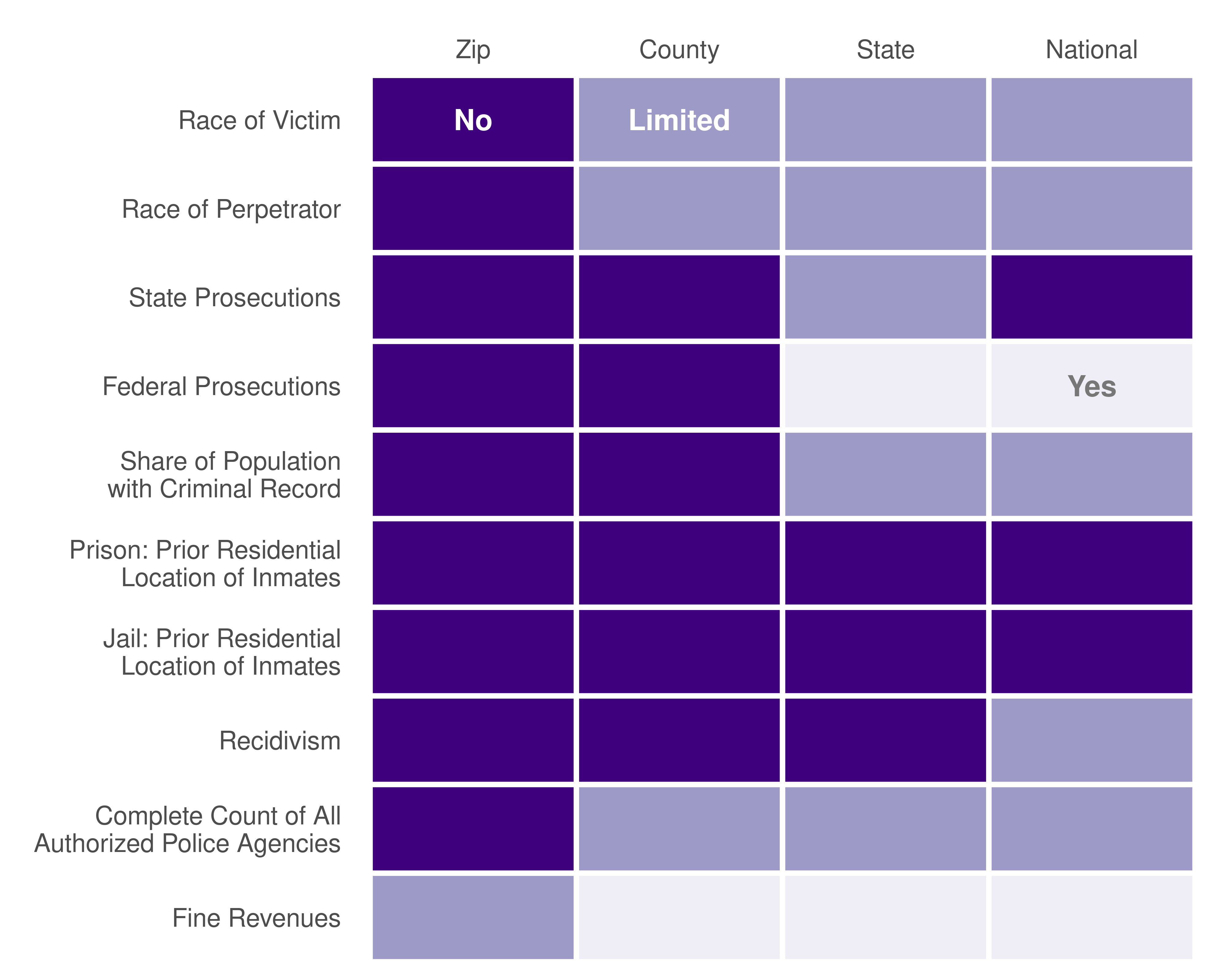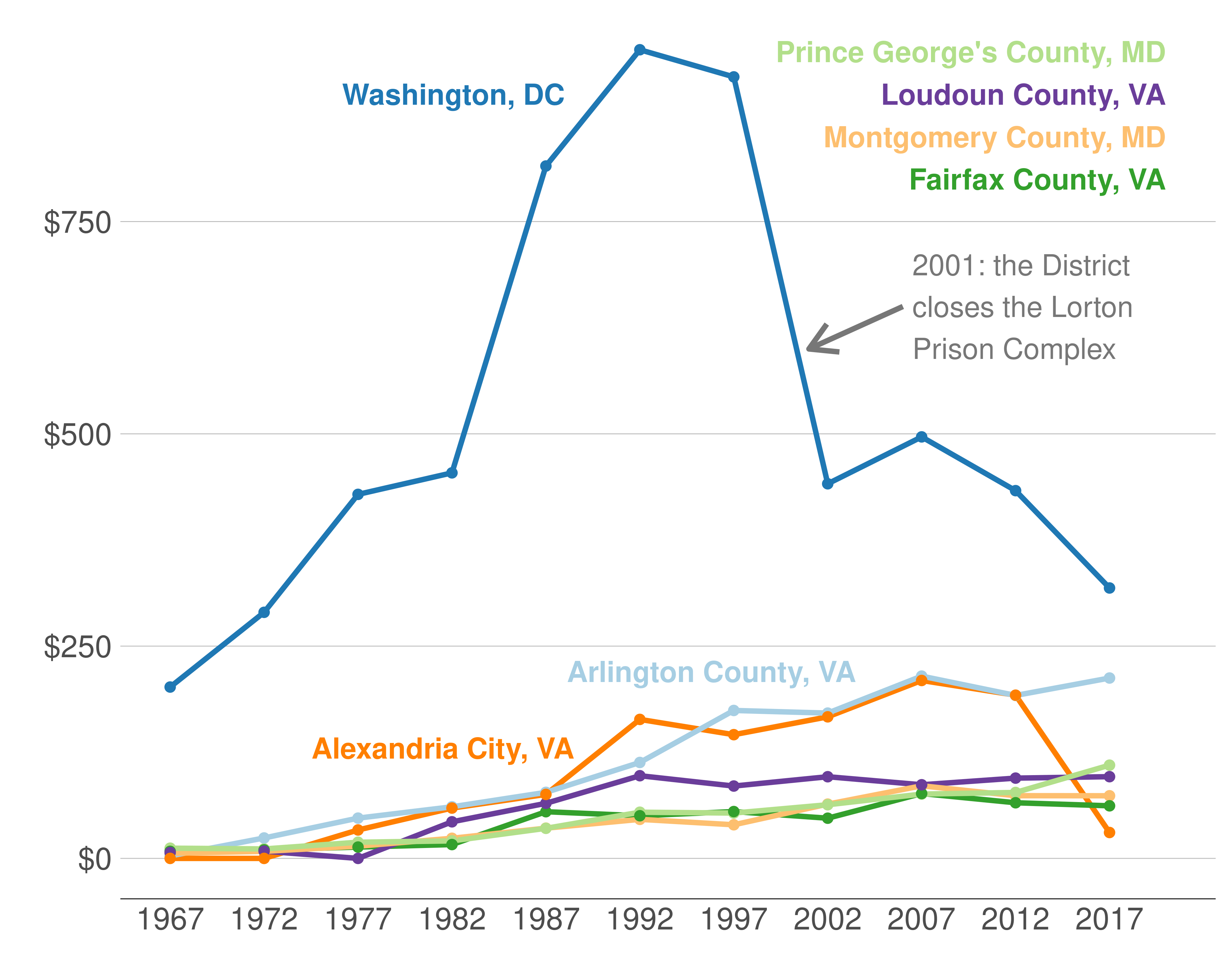Chapter 3: Conviction and Incarceration
The previous two chapters portrayed a historical pattern of fluctuating—and more recently increasing—levels of crime, combined with less volatile developments in resources dedicated to policing and private security. In this chapter, we illustrate some of the consequences these interacting trends have had for the rest of the criminal justice system: outcomes related to convictions and corrections.
The data available in these areas come with severe limitations. They are produced by a panoply of institutions, often provide incomplete coverage, and in other cases simply do not exist. To illustrate some of these problems, Figure 3.1 provides a high-level overview of data relevant to the issues covered in this chapter. We attempted to locate data on ten dimensions of conviction and incarceration at four levels of geographic granularity. As the figure shows, certain categories of data—especially data linking jail and prison populations to their prior place of residence—are difficult to come by. These lacunae are of particular importance to the District, as many residents convicted of felony offenses are sent to federal penitentiaries across the country. In many cases, attempts to produce estimates from existing data sources would require wild assumptions and imputations.
Figure 3.1: Criminal-Justice Data Limitations Are Notorious.
Presence or absence of data by different geographic units.

Source: This figure reflects data availability across a wide range of sources, including the Annual Survey of Jails, Census of State and Local Law Enforcement Agencies, the Census of State and Federal Adult Correctional Facilities, the National Longitudinal Survey of Youth, the Survey of Inmates in State and Federal Correctional Facilities, and various standard federal surveys of the population and labor force. Appendix 2 provides complete discussion.
Figure 3.2 illustrates a set of data availability issues more concretely, by showing the variation across jurisdictions of incident-level crime data – that is, a report of each crime by date, tied to a specific geographic location. As the figure shows, the availability of this data varies widely, and not in ways that are consistently related to the urban, suburban, or exurban character of each jurisdiction. A number of exurban jurisdictions make nearly no incident-level data available in systematic fashion, and the same holds true for Fairfax City. Of course, data availability is no panacea, as the District, with its high crimes rates, illustrates.
Figure 3.2: Availability of Incident-Level Data Varies Wildly Across the Region, Including its Core.
Capital Region jurisdictions by incident level data availability for 2023.


Source: Orange indicates that nearly no incident-level data is available on the county government or sheriff’s office’s website, though counts or incomplete regular incident reports without geographic detail may be available. Jurisdictions marked green make incident level available on a map, without direct access to the underlying dataset. Purple means comprehensive incident level data are presented in tabular form, sometimes with (partial) associated address information, but without coordinates. Blue jurisdictions provide comprehensive incident level data with coordinates. Appendix 3 provides complete discussion.
Moving on to the substance of conviction and incarceration levels, Figure 3.3 shows the number of federal felony convictions per capita in the District, Maryland, Virginia, and West Virginia. These are convictions for the states as a whole, not just those counties or neighborhoods in the Capital Region, illustrating one of the data limitations. Federal felony convictions are most common in the District.1 This should not come as a surprise: certain crimes that in other areas would be state-level felonies are federal crimes in the District. Perhaps surprisingly, the dramatic uptick in violent crime in the District in the past decade had yet to translate into an increase in felony convictions by 2021.
Figure 3.3: Federal Felony Convictions Are More Common in the District than in West Virginia, and Much More Common than in Maryland and Virginia.
Felony convictions per 100,000 residents, 1995 to 2021.

Source: United States Sentencing Commission Federal Sentencing Statistics Reports, 1995-2021. US Census Bureau’s State and County Intercensal Tables, 1990-1999. US Census Bureau’s PEP, 2000-2021.
Finally, when we turn to resources dedicated to incarceration, the District once again stands out. Corrections spending per capita, while less than half of what it was at its peak in the 1990s, remains significantly higher there than in a number of the largest surrounding jurisdictions: Prince George’s County, Loudoun County, Montgomery County, and Fairfax County.
Figure 3.4: Spending per Capita in the District Has Decreased but Remains Very High.
Corrections expenditure per capita from 1967 to 2017, largest Capital Region jurisdictions, 2021 dollars.

Source: The Government Finance Database, 1967-2017. We use data in years ending in 2 and 7 when the data are most complete. We use current expenditures and do not include capital expenditures. All numbers are in 2021 dollars.
In the District of Columbia, felonies may be prosecuted in District Court or Superior Court. Figure 3.3 shows prosecutions in District Court.↩︎